L'Epopée napoléonienne/Napoleon Bonaparte (Lucien Nonguet, 1903) is an early biopic by Pathé Frères. The Historic drama shows some highlights of the career of Napoléon, like the Coronation, the battle of Austerlitz, the soldier sleeping during watch, the burning of Moscow, Waterloo and the Emperor's death. Several postcard series were produced for the film, including one in France by Rex and one in Italy by the famous postcard publisher Alterocca with also French captions.
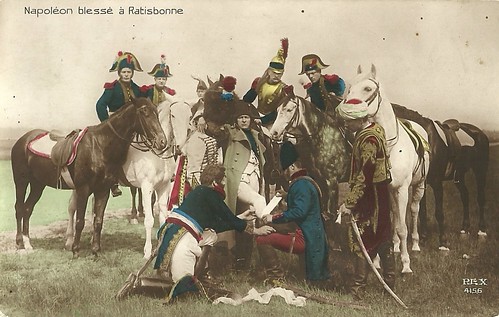
French postcard by Rex, no. 4156. Photo: Pathé Frères. Publicity still for Epopée napoléonienne (Lucien Nonguet, 1903). Caption: Napoléon blessé à Ratisbonne.
The image above was vaguely based on the painting Napoléon blessé à Ratisbonne (Napoleon hurt at Regensburg, 1810) by Pierre Gautherot. The scene depicted the only moment Bonaparte was hurt when fighting, on 23 April 1809. The painting is now at the Musée national du chateau de Versailles.
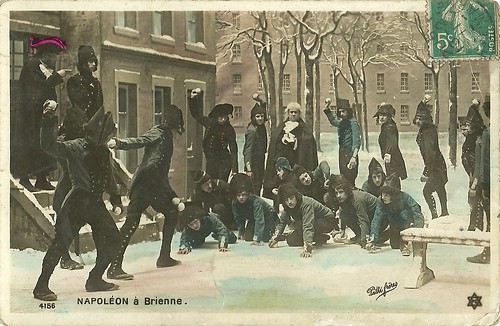
French postcard by PC, no. 4156. Photo: Pathé Frères. Publicity still for L'Epopée napoléonienne (Lucien Nonguet, 1903). Caption: Napoléon à Brienne.
The scene above depicts one of the Napoléon legends, also painted by Horace Vernet, and dazzingly staged on film by Abel Gance. Already at the military academy a young Bonaparte whould have showed his strategic leadership during a snowball fight.
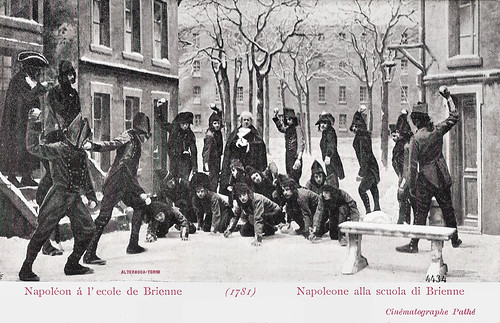
Italian postcard by Alterocca, Terni, no. 4434. Photo: Cinématographe Pathé. Publicity still for L'Epopée napoléonienne (Lucien Nonguet, 1903). Caption: Napoléon à l'école de Brienne (1781).
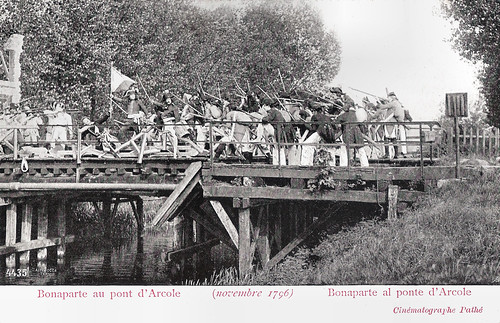
Italian postcard by Alterocca, Terni, no. 4435. Photo: Cinématographe Pathé. Publicity still for L'Epopée napoléonienne (Lucien Nonguet, 1903). Caption: Bonaparte au pont d'Arcole (novembre 1796).
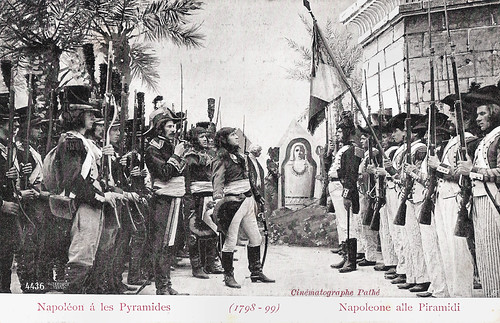
Italian postcard by Alterocca, Terni, no. 4436. Photo: Cinématographe Pathé. Publicity still for L'Epopée napoléonienne (Lucien Nonguet, 1903). Caption: Napoléon á les Pyramides (1798-99).
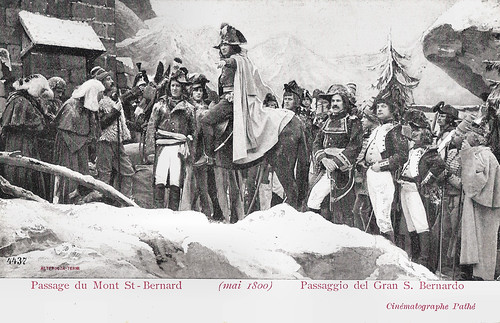
Italian postcard by Alterocca, Terni, no. 4437. Photo: Cinématographe Pathé. Publicity still for L'Epopée napoléonienne (Lucien Nonguet, 1903). Caption: Passage du Mont St.-Bernard (mai 1800).
Napoléon Bonaparte (1769-1821), born Napoleone di Buonaparte, was a French military and political leader who rose to prominence during the French Revolution. He led several successful campaigns during the French Revolutionary Wars.
He was born in Corsica to a relatively modest family from the minor nobility. When the Revolution broke out in 1789, Napoleon was serving as an artillery officer in the French army. Seizing the new opportunities presented by the Revolution, he rapidly rose through the ranks of the military, becoming a general at age 24.
At age 26, he began his first military campaign against the Austrians and their Italian allies—winning virtually every battle, conquering the Italian Peninsula in a year, and becoming a national hero. In 1798, he led a military expedition to Egypt that served as a springboard to political power. He engineered a coup in November 1799 and became First Consul of the Republic. His ambition and public approval inspired him to go further.
In 1804 he became the first Emperor of the French. As Napoléon I, he was Emperor of the French from 1804 until 1814, and again in 1815. Napoleon dominated European and global affairs for more than a decade while leading France against a series of coalitions in the Napoleonic Wars.
He won most of these wars and the vast majority of his battles, building a large empire that ruled over continental Europe before its final collapse in 1815.
Napoléon has become a worldwide cultural icon who symbolises military genius and political power. One of the greatest commanders in history, his wars and campaigns are studied at military schools worldwide. Napoléon's political and cultural legacy has ensured his status as one of the most celebrated and controversial leaders in human history.
Napoléon has been portrayed in many works of fiction, his depiction varying greatly with the author's perception of the historical character. Best known is probably the classic silent film Napoleon (Abel Gance, 1927), with young general Bonaparte is portrayed as a heroic visionary.
L'Epopée napoléonienne (1903) was made by Lucien Nonguet, a former crowd-scene manager at several thetres, including the Ambigu and the Châtelet in Paris. He was specialised in actualités and historical reconstructions.
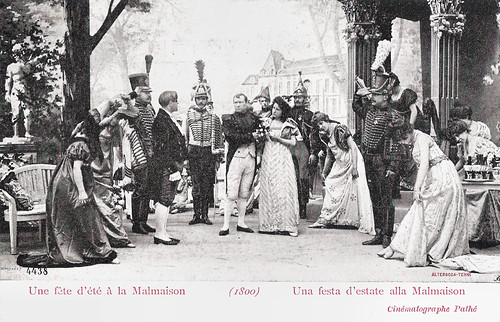
Italian postcard by Alterocca, Terni, no. 4438. Photo: Cinématographe Pathé. Publicity still for L'Epopée napoléonienne (Lucien Nonguet, 1903). Caption: Une fête d'été à la Malmaison (1800).
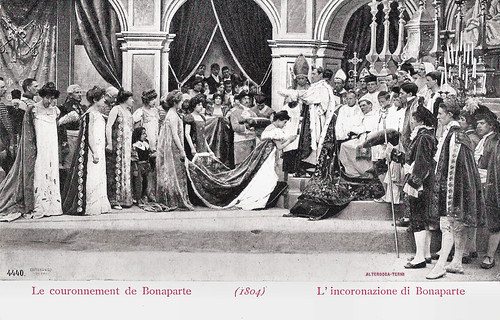
Italian postcard by Alterocca, Terni, no. 4440. Photo: Cinématographe Pathé. Publicity still for L'Epopée napoléonienne (Lucien Nonguet, 1903). Caption: Le Couronnement de Bonaparte (1804).
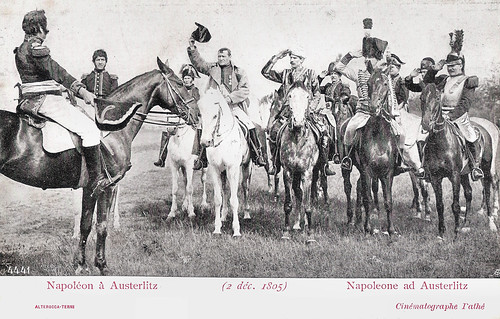
Italian postcard by Alterocca, Terni, no. 4441. Photo: Cinématographe Pathé. Publicity still for L'Epopée napoléonienne (Lucien Nonguet, 1903). Caption: Napoléon à Austerlitz (2 déc. 1805).
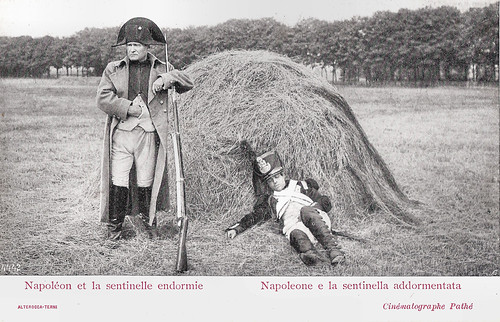
Italian postcard by Alterocca, Terni, no. 4442. Photo: Cinématographe Pathé. Publicity still for L'Epopée napoléonienne (Lucien Nonguet, 1903). Caption: Napoléon et la sentinelle endormie.
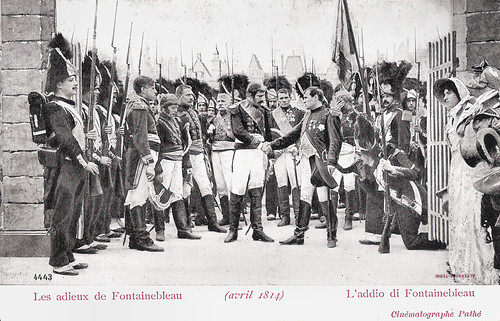
Italian postcard by Alterocca, Terni, no. 4443. Photo: Cinématographe Pathé. Publicity still for L'Epopée napoléonienne (Lucien Nonguet, 1903). Caption: Les adieux de Fontainebleau (avril 1814).
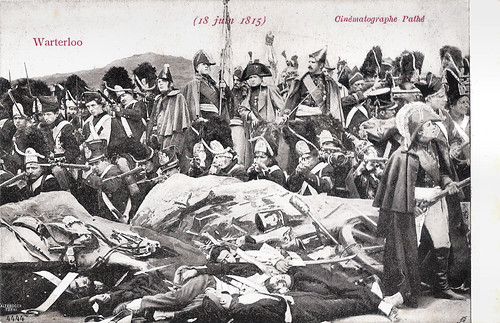
Italian postcard by Alterocca, Terni, no. 4444. Photo: Cinématographe Pathé. Publicity still for L'Epopée napoléonienne (Lucien Nonguet, 1903). Caption: Waterloo (18 juin 1815).
Sources: Richard Abel (The Ciné Goes to Town: French Cinema, 1896-1914), Wikipedia and IMDb.

French postcard by Rex, no. 4156. Photo: Pathé Frères. Publicity still for Epopée napoléonienne (Lucien Nonguet, 1903). Caption: Napoléon blessé à Ratisbonne.
The image above was vaguely based on the painting Napoléon blessé à Ratisbonne (Napoleon hurt at Regensburg, 1810) by Pierre Gautherot. The scene depicted the only moment Bonaparte was hurt when fighting, on 23 April 1809. The painting is now at the Musée national du chateau de Versailles.

French postcard by PC, no. 4156. Photo: Pathé Frères. Publicity still for L'Epopée napoléonienne (Lucien Nonguet, 1903). Caption: Napoléon à Brienne.
The scene above depicts one of the Napoléon legends, also painted by Horace Vernet, and dazzingly staged on film by Abel Gance. Already at the military academy a young Bonaparte whould have showed his strategic leadership during a snowball fight.

Italian postcard by Alterocca, Terni, no. 4434. Photo: Cinématographe Pathé. Publicity still for L'Epopée napoléonienne (Lucien Nonguet, 1903). Caption: Napoléon à l'école de Brienne (1781).

Italian postcard by Alterocca, Terni, no. 4435. Photo: Cinématographe Pathé. Publicity still for L'Epopée napoléonienne (Lucien Nonguet, 1903). Caption: Bonaparte au pont d'Arcole (novembre 1796).

Italian postcard by Alterocca, Terni, no. 4436. Photo: Cinématographe Pathé. Publicity still for L'Epopée napoléonienne (Lucien Nonguet, 1903). Caption: Napoléon á les Pyramides (1798-99).

Italian postcard by Alterocca, Terni, no. 4437. Photo: Cinématographe Pathé. Publicity still for L'Epopée napoléonienne (Lucien Nonguet, 1903). Caption: Passage du Mont St.-Bernard (mai 1800).
A worldwide cultural icon
Napoléon Bonaparte (1769-1821), born Napoleone di Buonaparte, was a French military and political leader who rose to prominence during the French Revolution. He led several successful campaigns during the French Revolutionary Wars.
He was born in Corsica to a relatively modest family from the minor nobility. When the Revolution broke out in 1789, Napoleon was serving as an artillery officer in the French army. Seizing the new opportunities presented by the Revolution, he rapidly rose through the ranks of the military, becoming a general at age 24.
At age 26, he began his first military campaign against the Austrians and their Italian allies—winning virtually every battle, conquering the Italian Peninsula in a year, and becoming a national hero. In 1798, he led a military expedition to Egypt that served as a springboard to political power. He engineered a coup in November 1799 and became First Consul of the Republic. His ambition and public approval inspired him to go further.
In 1804 he became the first Emperor of the French. As Napoléon I, he was Emperor of the French from 1804 until 1814, and again in 1815. Napoleon dominated European and global affairs for more than a decade while leading France against a series of coalitions in the Napoleonic Wars.
He won most of these wars and the vast majority of his battles, building a large empire that ruled over continental Europe before its final collapse in 1815.
Napoléon has become a worldwide cultural icon who symbolises military genius and political power. One of the greatest commanders in history, his wars and campaigns are studied at military schools worldwide. Napoléon's political and cultural legacy has ensured his status as one of the most celebrated and controversial leaders in human history.
Napoléon has been portrayed in many works of fiction, his depiction varying greatly with the author's perception of the historical character. Best known is probably the classic silent film Napoleon (Abel Gance, 1927), with young general Bonaparte is portrayed as a heroic visionary.
L'Epopée napoléonienne (1903) was made by Lucien Nonguet, a former crowd-scene manager at several thetres, including the Ambigu and the Châtelet in Paris. He was specialised in actualités and historical reconstructions.

Italian postcard by Alterocca, Terni, no. 4438. Photo: Cinématographe Pathé. Publicity still for L'Epopée napoléonienne (Lucien Nonguet, 1903). Caption: Une fête d'été à la Malmaison (1800).

Italian postcard by Alterocca, Terni, no. 4440. Photo: Cinématographe Pathé. Publicity still for L'Epopée napoléonienne (Lucien Nonguet, 1903). Caption: Le Couronnement de Bonaparte (1804).

Italian postcard by Alterocca, Terni, no. 4441. Photo: Cinématographe Pathé. Publicity still for L'Epopée napoléonienne (Lucien Nonguet, 1903). Caption: Napoléon à Austerlitz (2 déc. 1805).

Italian postcard by Alterocca, Terni, no. 4442. Photo: Cinématographe Pathé. Publicity still for L'Epopée napoléonienne (Lucien Nonguet, 1903). Caption: Napoléon et la sentinelle endormie.

Italian postcard by Alterocca, Terni, no. 4443. Photo: Cinématographe Pathé. Publicity still for L'Epopée napoléonienne (Lucien Nonguet, 1903). Caption: Les adieux de Fontainebleau (avril 1814).

Italian postcard by Alterocca, Terni, no. 4444. Photo: Cinématographe Pathé. Publicity still for L'Epopée napoléonienne (Lucien Nonguet, 1903). Caption: Waterloo (18 juin 1815).
Sources: Richard Abel (The Ciné Goes to Town: French Cinema, 1896-1914), Wikipedia and IMDb.
No comments:
Post a Comment